TESCO: Analysing Organisational Behaviour and Management Practices
VerifiedAdded on 2023/01/06
|9
|2555
|55
Report
AI Summary
This report provides a comprehensive analysis of TESCO's organisational behaviour and management practices. It begins with an introduction to the company, its background, and key motivation theories relevant to its operations. The main body delves into the application of McKinsey's 7-S model, evaluating its effectiveness in the context of change management within TESCO. The report examines the implementation of motivation theories, particularly equity theory and reinforcement theory, to address challenges related to workforce diversity and employee behaviour, specifically focusing on migrant workers. Recommendations are provided for adopting changes in employee behaviour, including strategic direction, a powerful management system, and the importance of clear leadership. The report concludes by emphasizing the significance of change management in enhancing productivity and profitability, highlighting the role of motivation in achieving organisational goals. References include books and journals that support the analysis.
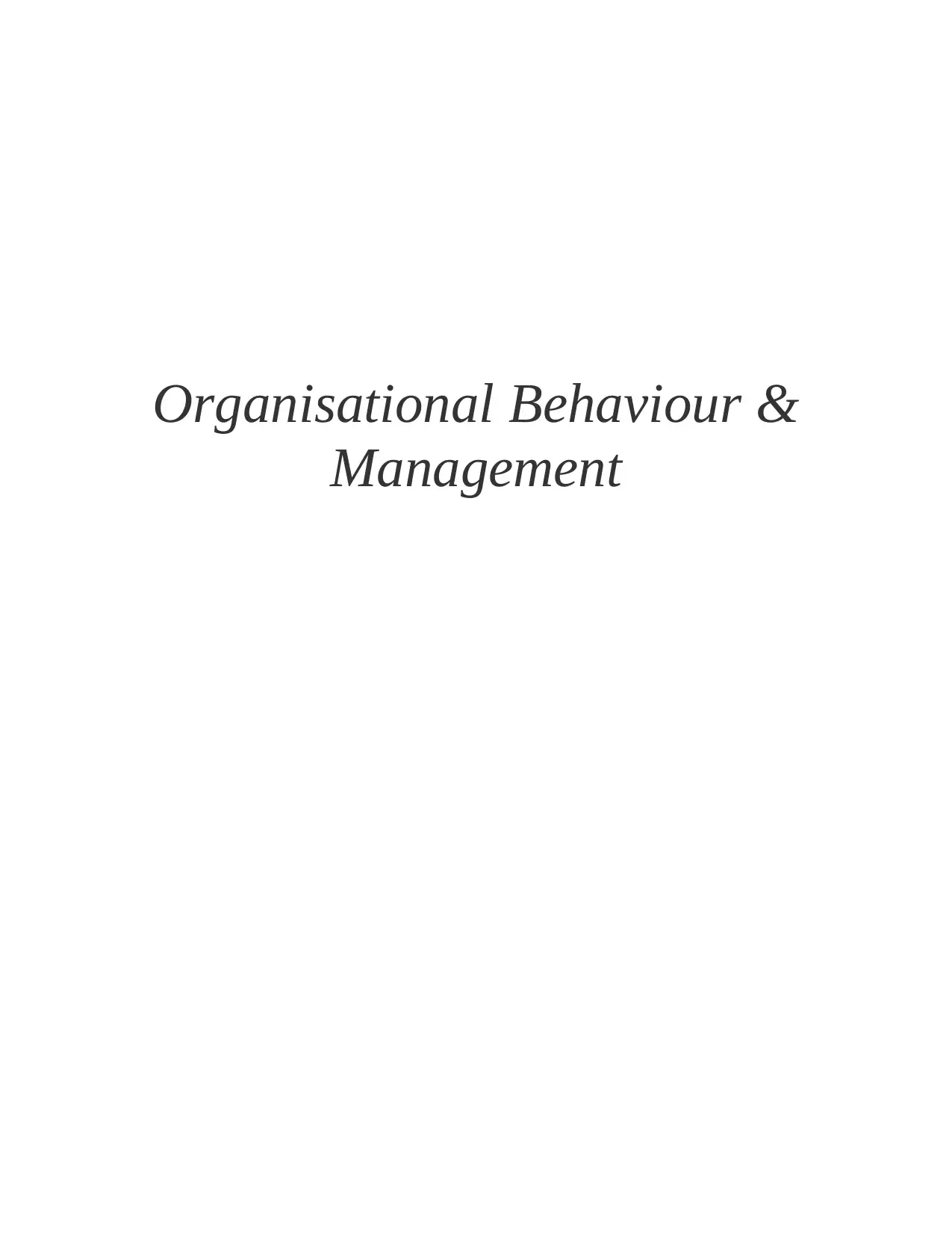
Organisational Behaviour &
Management
Management
Paraphrase This Document
Need a fresh take? Get an instant paraphrase of this document with our AI Paraphraser
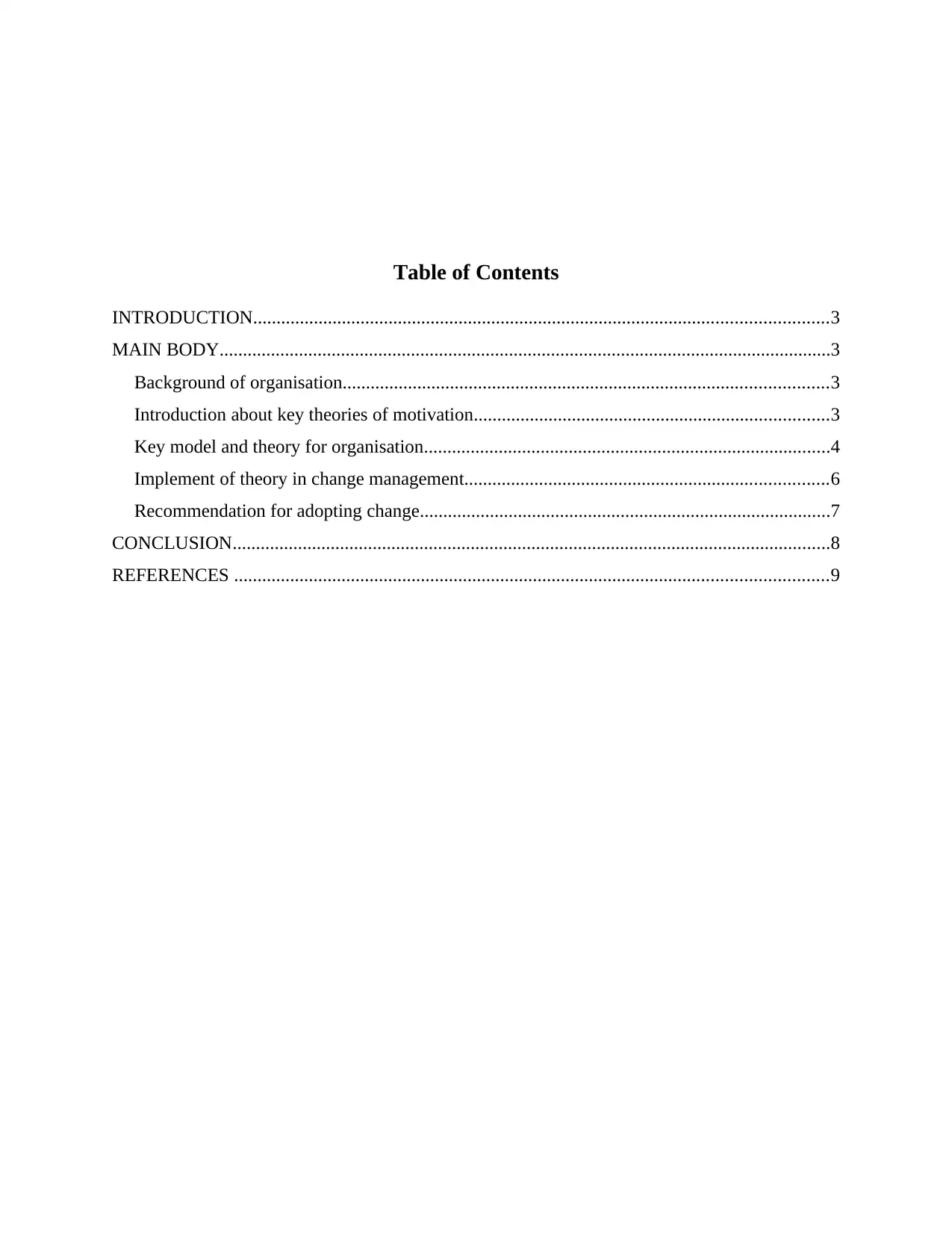
Table of Contents
INTRODUCTION...........................................................................................................................3
MAIN BODY...................................................................................................................................3
Background of organisation........................................................................................................3
Introduction about key theories of motivation............................................................................3
Key model and theory for organisation.......................................................................................4
Implement of theory in change management..............................................................................6
Recommendation for adopting change........................................................................................7
CONCLUSION................................................................................................................................8
REFERENCES ...............................................................................................................................9
INTRODUCTION...........................................................................................................................3
MAIN BODY...................................................................................................................................3
Background of organisation........................................................................................................3
Introduction about key theories of motivation............................................................................3
Key model and theory for organisation.......................................................................................4
Implement of theory in change management..............................................................................6
Recommendation for adopting change........................................................................................7
CONCLUSION................................................................................................................................8
REFERENCES ...............................................................................................................................9
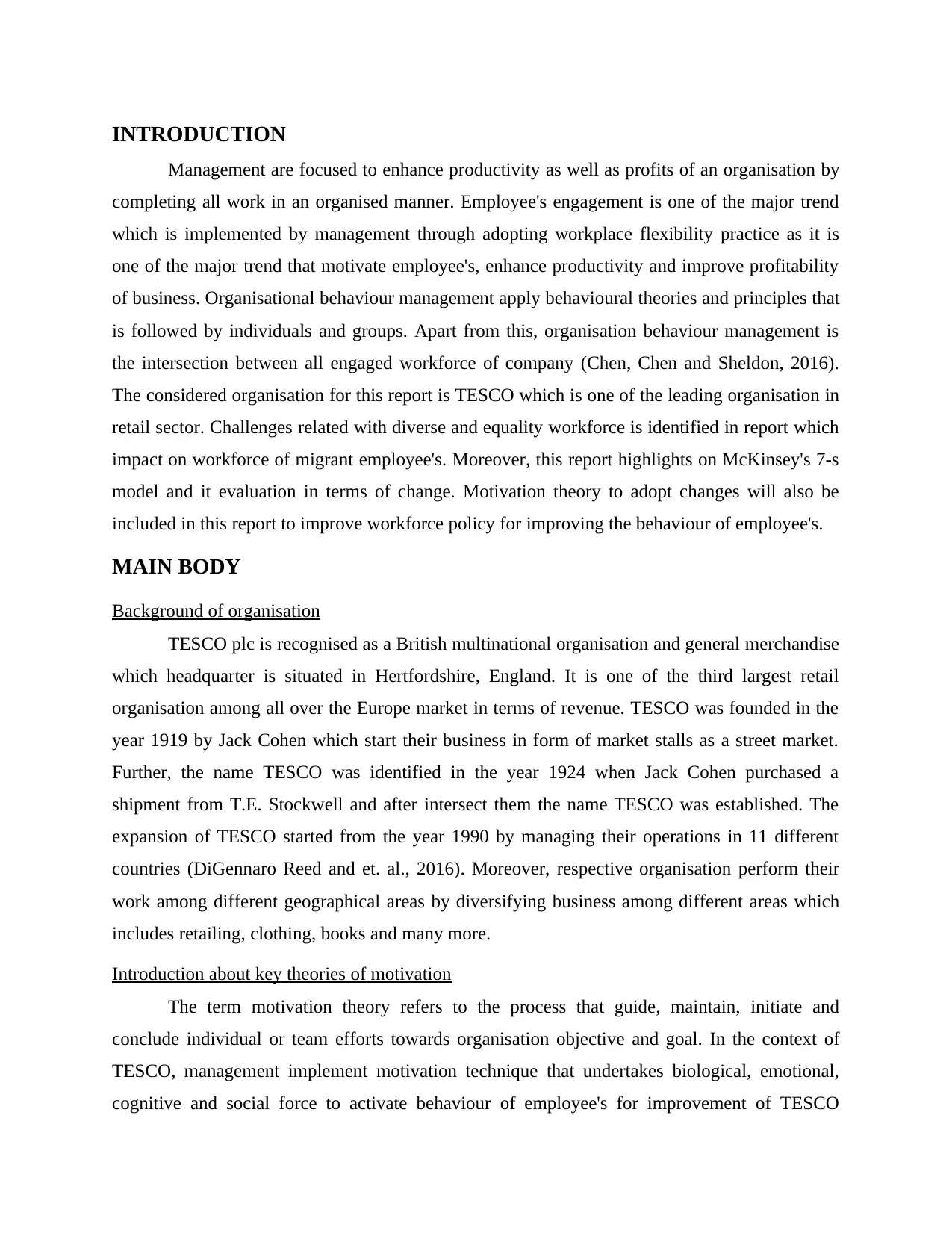
INTRODUCTION
Management are focused to enhance productivity as well as profits of an organisation by
completing all work in an organised manner. Employee's engagement is one of the major trend
which is implemented by management through adopting workplace flexibility practice as it is
one of the major trend that motivate employee's, enhance productivity and improve profitability
of business. Organisational behaviour management apply behavioural theories and principles that
is followed by individuals and groups. Apart from this, organisation behaviour management is
the intersection between all engaged workforce of company (Chen, Chen and Sheldon, 2016).
The considered organisation for this report is TESCO which is one of the leading organisation in
retail sector. Challenges related with diverse and equality workforce is identified in report which
impact on workforce of migrant employee's. Moreover, this report highlights on McKinsey's 7-s
model and it evaluation in terms of change. Motivation theory to adopt changes will also be
included in this report to improve workforce policy for improving the behaviour of employee's.
MAIN BODY
Background of organisation
TESCO plc is recognised as a British multinational organisation and general merchandise
which headquarter is situated in Hertfordshire, England. It is one of the third largest retail
organisation among all over the Europe market in terms of revenue. TESCO was founded in the
year 1919 by Jack Cohen which start their business in form of market stalls as a street market.
Further, the name TESCO was identified in the year 1924 when Jack Cohen purchased a
shipment from T.E. Stockwell and after intersect them the name TESCO was established. The
expansion of TESCO started from the year 1990 by managing their operations in 11 different
countries (DiGennaro Reed and et. al., 2016). Moreover, respective organisation perform their
work among different geographical areas by diversifying business among different areas which
includes retailing, clothing, books and many more.
Introduction about key theories of motivation
The term motivation theory refers to the process that guide, maintain, initiate and
conclude individual or team efforts towards organisation objective and goal. In the context of
TESCO, management implement motivation technique that undertakes biological, emotional,
cognitive and social force to activate behaviour of employee's for improvement of TESCO
Management are focused to enhance productivity as well as profits of an organisation by
completing all work in an organised manner. Employee's engagement is one of the major trend
which is implemented by management through adopting workplace flexibility practice as it is
one of the major trend that motivate employee's, enhance productivity and improve profitability
of business. Organisational behaviour management apply behavioural theories and principles that
is followed by individuals and groups. Apart from this, organisation behaviour management is
the intersection between all engaged workforce of company (Chen, Chen and Sheldon, 2016).
The considered organisation for this report is TESCO which is one of the leading organisation in
retail sector. Challenges related with diverse and equality workforce is identified in report which
impact on workforce of migrant employee's. Moreover, this report highlights on McKinsey's 7-s
model and it evaluation in terms of change. Motivation theory to adopt changes will also be
included in this report to improve workforce policy for improving the behaviour of employee's.
MAIN BODY
Background of organisation
TESCO plc is recognised as a British multinational organisation and general merchandise
which headquarter is situated in Hertfordshire, England. It is one of the third largest retail
organisation among all over the Europe market in terms of revenue. TESCO was founded in the
year 1919 by Jack Cohen which start their business in form of market stalls as a street market.
Further, the name TESCO was identified in the year 1924 when Jack Cohen purchased a
shipment from T.E. Stockwell and after intersect them the name TESCO was established. The
expansion of TESCO started from the year 1990 by managing their operations in 11 different
countries (DiGennaro Reed and et. al., 2016). Moreover, respective organisation perform their
work among different geographical areas by diversifying business among different areas which
includes retailing, clothing, books and many more.
Introduction about key theories of motivation
The term motivation theory refers to the process that guide, maintain, initiate and
conclude individual or team efforts towards organisation objective and goal. In the context of
TESCO, management implement motivation technique that undertakes biological, emotional,
cognitive and social force to activate behaviour of employee's for improvement of TESCO
⊘ This is a preview!⊘
Do you want full access?
Subscribe today to unlock all pages.

Trusted by 1+ million students worldwide
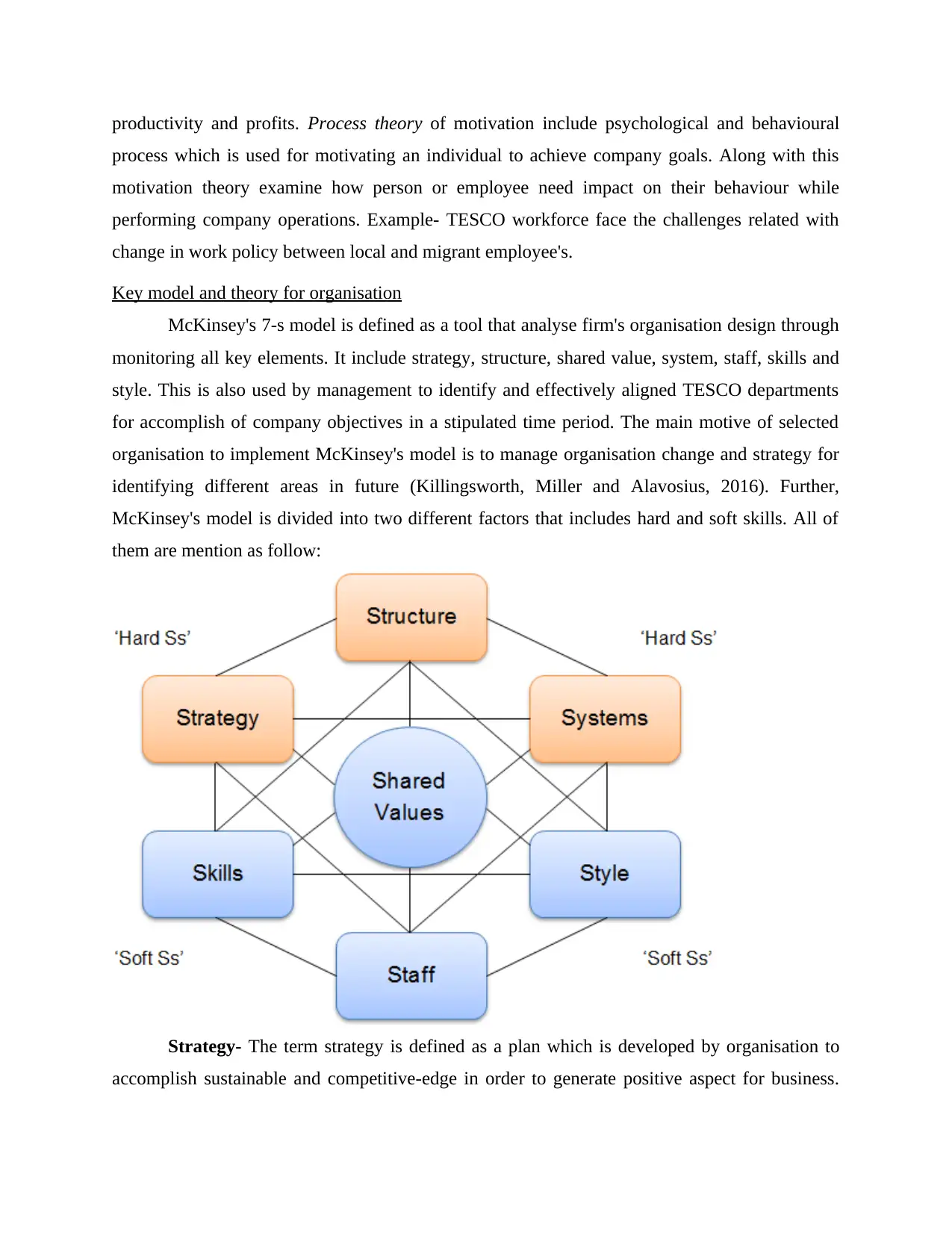
productivity and profits. Process theory of motivation include psychological and behavioural
process which is used for motivating an individual to achieve company goals. Along with this
motivation theory examine how person or employee need impact on their behaviour while
performing company operations. Example- TESCO workforce face the challenges related with
change in work policy between local and migrant employee's.
Key model and theory for organisation
McKinsey's 7-s model is defined as a tool that analyse firm's organisation design through
monitoring all key elements. It include strategy, structure, shared value, system, staff, skills and
style. This is also used by management to identify and effectively aligned TESCO departments
for accomplish of company objectives in a stipulated time period. The main motive of selected
organisation to implement McKinsey's model is to manage organisation change and strategy for
identifying different areas in future (Killingsworth, Miller and Alavosius, 2016). Further,
McKinsey's model is divided into two different factors that includes hard and soft skills. All of
them are mention as follow:
Strategy- The term strategy is defined as a plan which is developed by organisation to
accomplish sustainable and competitive-edge in order to generate positive aspect for business.
process which is used for motivating an individual to achieve company goals. Along with this
motivation theory examine how person or employee need impact on their behaviour while
performing company operations. Example- TESCO workforce face the challenges related with
change in work policy between local and migrant employee's.
Key model and theory for organisation
McKinsey's 7-s model is defined as a tool that analyse firm's organisation design through
monitoring all key elements. It include strategy, structure, shared value, system, staff, skills and
style. This is also used by management to identify and effectively aligned TESCO departments
for accomplish of company objectives in a stipulated time period. The main motive of selected
organisation to implement McKinsey's model is to manage organisation change and strategy for
identifying different areas in future (Killingsworth, Miller and Alavosius, 2016). Further,
McKinsey's model is divided into two different factors that includes hard and soft skills. All of
them are mention as follow:
Strategy- The term strategy is defined as a plan which is developed by organisation to
accomplish sustainable and competitive-edge in order to generate positive aspect for business.
Paraphrase This Document
Need a fresh take? Get an instant paraphrase of this document with our AI Paraphraser
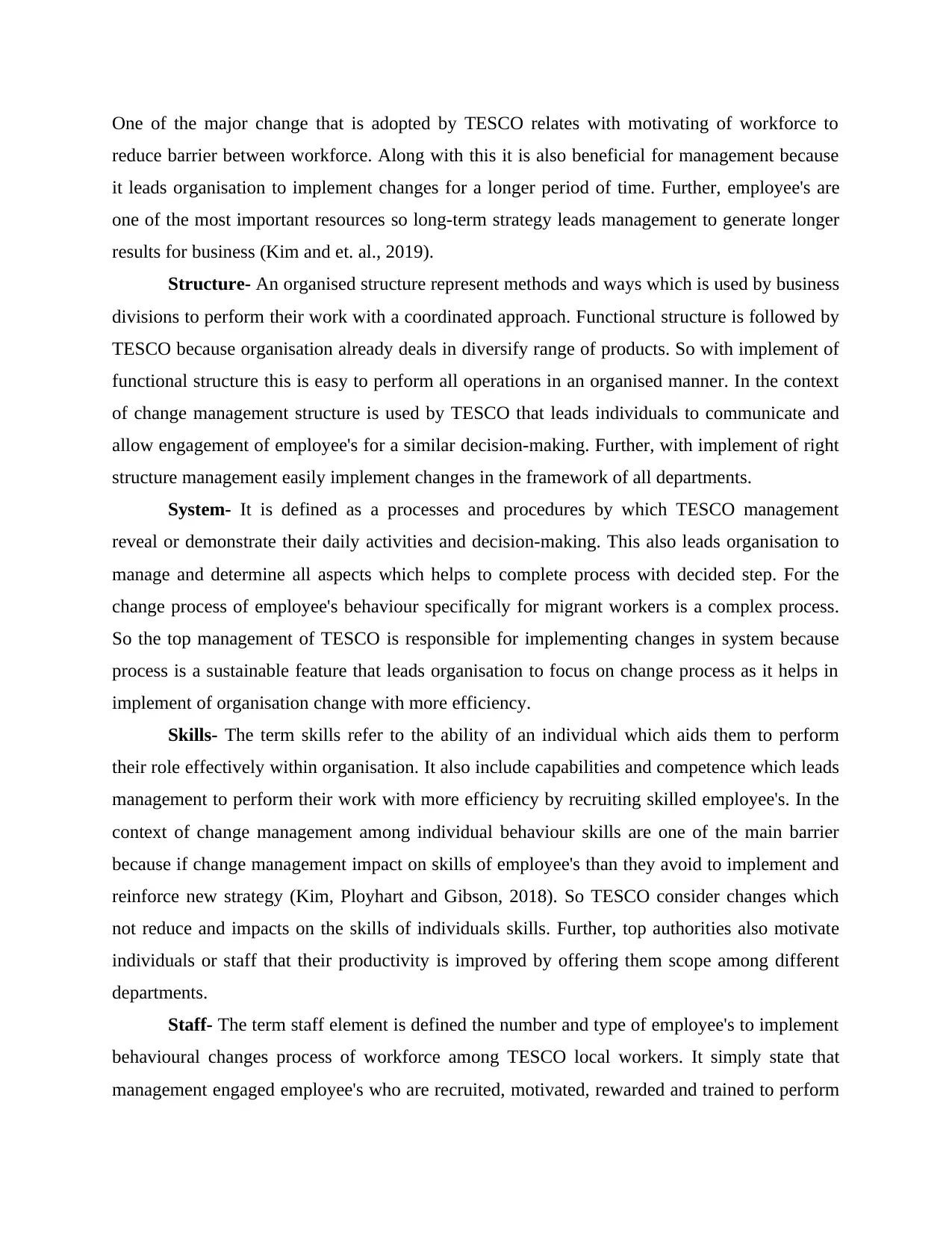
One of the major change that is adopted by TESCO relates with motivating of workforce to
reduce barrier between workforce. Along with this it is also beneficial for management because
it leads organisation to implement changes for a longer period of time. Further, employee's are
one of the most important resources so long-term strategy leads management to generate longer
results for business (Kim and et. al., 2019).
Structure- An organised structure represent methods and ways which is used by business
divisions to perform their work with a coordinated approach. Functional structure is followed by
TESCO because organisation already deals in diversify range of products. So with implement of
functional structure this is easy to perform all operations in an organised manner. In the context
of change management structure is used by TESCO that leads individuals to communicate and
allow engagement of employee's for a similar decision-making. Further, with implement of right
structure management easily implement changes in the framework of all departments.
System- It is defined as a processes and procedures by which TESCO management
reveal or demonstrate their daily activities and decision-making. This also leads organisation to
manage and determine all aspects which helps to complete process with decided step. For the
change process of employee's behaviour specifically for migrant workers is a complex process.
So the top management of TESCO is responsible for implementing changes in system because
process is a sustainable feature that leads organisation to focus on change process as it helps in
implement of organisation change with more efficiency.
Skills- The term skills refer to the ability of an individual which aids them to perform
their role effectively within organisation. It also include capabilities and competence which leads
management to perform their work with more efficiency by recruiting skilled employee's. In the
context of change management among individual behaviour skills are one of the main barrier
because if change management impact on skills of employee's than they avoid to implement and
reinforce new strategy (Kim, Ployhart and Gibson, 2018). So TESCO consider changes which
not reduce and impacts on the skills of individuals skills. Further, top authorities also motivate
individuals or staff that their productivity is improved by offering them scope among different
departments.
Staff- The term staff element is defined the number and type of employee's to implement
behavioural changes process of workforce among TESCO local workers. It simply state that
management engaged employee's who are recruited, motivated, rewarded and trained to perform
reduce barrier between workforce. Along with this it is also beneficial for management because
it leads organisation to implement changes for a longer period of time. Further, employee's are
one of the most important resources so long-term strategy leads management to generate longer
results for business (Kim and et. al., 2019).
Structure- An organised structure represent methods and ways which is used by business
divisions to perform their work with a coordinated approach. Functional structure is followed by
TESCO because organisation already deals in diversify range of products. So with implement of
functional structure this is easy to perform all operations in an organised manner. In the context
of change management structure is used by TESCO that leads individuals to communicate and
allow engagement of employee's for a similar decision-making. Further, with implement of right
structure management easily implement changes in the framework of all departments.
System- It is defined as a processes and procedures by which TESCO management
reveal or demonstrate their daily activities and decision-making. This also leads organisation to
manage and determine all aspects which helps to complete process with decided step. For the
change process of employee's behaviour specifically for migrant workers is a complex process.
So the top management of TESCO is responsible for implementing changes in system because
process is a sustainable feature that leads organisation to focus on change process as it helps in
implement of organisation change with more efficiency.
Skills- The term skills refer to the ability of an individual which aids them to perform
their role effectively within organisation. It also include capabilities and competence which leads
management to perform their work with more efficiency by recruiting skilled employee's. In the
context of change management among individual behaviour skills are one of the main barrier
because if change management impact on skills of employee's than they avoid to implement and
reinforce new strategy (Kim, Ployhart and Gibson, 2018). So TESCO consider changes which
not reduce and impacts on the skills of individuals skills. Further, top authorities also motivate
individuals or staff that their productivity is improved by offering them scope among different
departments.
Staff- The term staff element is defined the number and type of employee's to implement
behavioural changes process of workforce among TESCO local workers. It simply state that
management engaged employee's who are recruited, motivated, rewarded and trained to perform
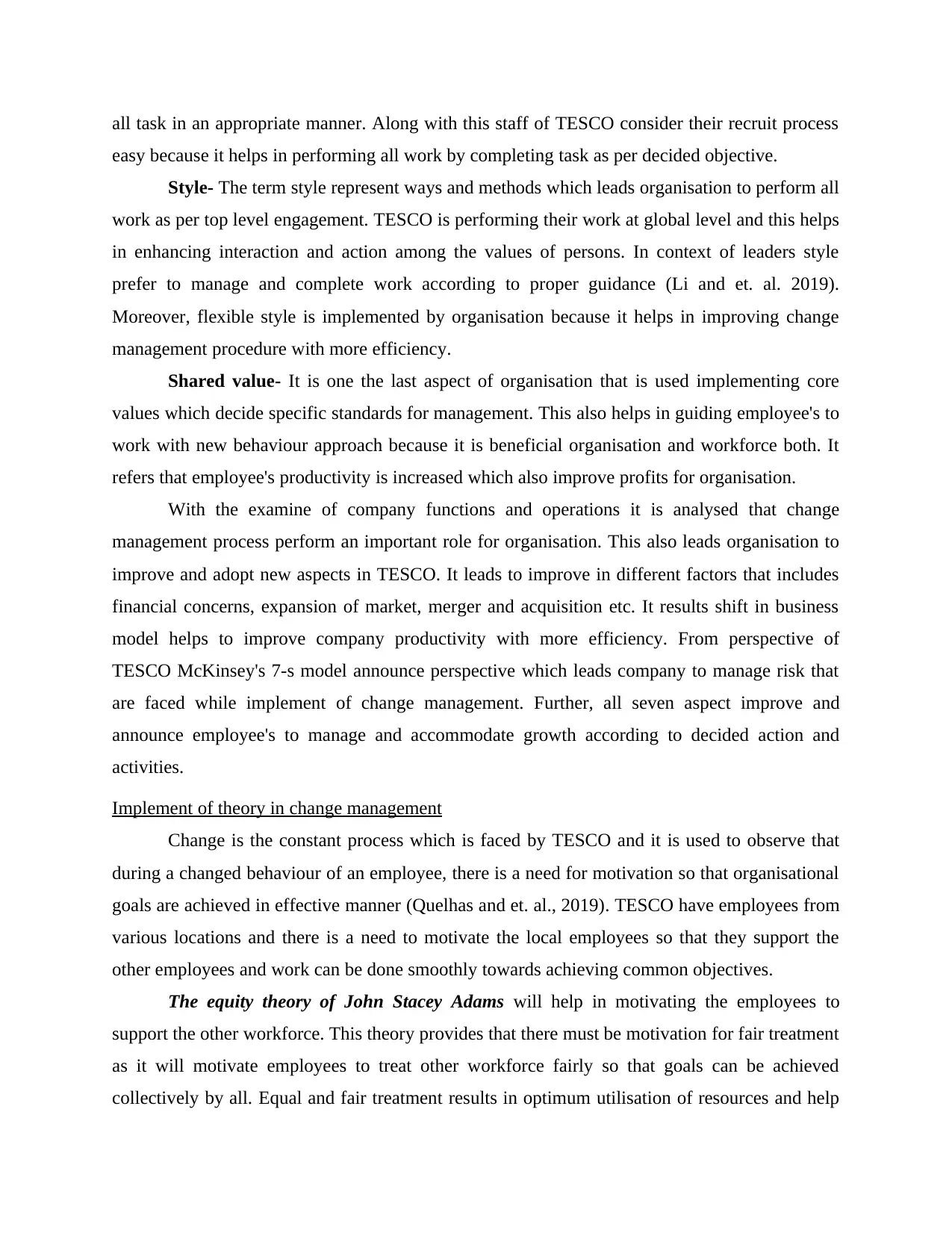
all task in an appropriate manner. Along with this staff of TESCO consider their recruit process
easy because it helps in performing all work by completing task as per decided objective.
Style- The term style represent ways and methods which leads organisation to perform all
work as per top level engagement. TESCO is performing their work at global level and this helps
in enhancing interaction and action among the values of persons. In context of leaders style
prefer to manage and complete work according to proper guidance (Li and et. al. 2019).
Moreover, flexible style is implemented by organisation because it helps in improving change
management procedure with more efficiency.
Shared value- It is one the last aspect of organisation that is used implementing core
values which decide specific standards for management. This also helps in guiding employee's to
work with new behaviour approach because it is beneficial organisation and workforce both. It
refers that employee's productivity is increased which also improve profits for organisation.
With the examine of company functions and operations it is analysed that change
management process perform an important role for organisation. This also leads organisation to
improve and adopt new aspects in TESCO. It leads to improve in different factors that includes
financial concerns, expansion of market, merger and acquisition etc. It results shift in business
model helps to improve company productivity with more efficiency. From perspective of
TESCO McKinsey's 7-s model announce perspective which leads company to manage risk that
are faced while implement of change management. Further, all seven aspect improve and
announce employee's to manage and accommodate growth according to decided action and
activities.
Implement of theory in change management
Change is the constant process which is faced by TESCO and it is used to observe that
during a changed behaviour of an employee, there is a need for motivation so that organisational
goals are achieved in effective manner (Quelhas and et. al., 2019). TESCO have employees from
various locations and there is a need to motivate the local employees so that they support the
other employees and work can be done smoothly towards achieving common objectives.
The equity theory of John Stacey Adams will help in motivating the employees to
support the other workforce. This theory provides that there must be motivation for fair treatment
as it will motivate employees to treat other workforce fairly so that goals can be achieved
collectively by all. Equal and fair treatment results in optimum utilisation of resources and help
easy because it helps in performing all work by completing task as per decided objective.
Style- The term style represent ways and methods which leads organisation to perform all
work as per top level engagement. TESCO is performing their work at global level and this helps
in enhancing interaction and action among the values of persons. In context of leaders style
prefer to manage and complete work according to proper guidance (Li and et. al. 2019).
Moreover, flexible style is implemented by organisation because it helps in improving change
management procedure with more efficiency.
Shared value- It is one the last aspect of organisation that is used implementing core
values which decide specific standards for management. This also helps in guiding employee's to
work with new behaviour approach because it is beneficial organisation and workforce both. It
refers that employee's productivity is increased which also improve profits for organisation.
With the examine of company functions and operations it is analysed that change
management process perform an important role for organisation. This also leads organisation to
improve and adopt new aspects in TESCO. It leads to improve in different factors that includes
financial concerns, expansion of market, merger and acquisition etc. It results shift in business
model helps to improve company productivity with more efficiency. From perspective of
TESCO McKinsey's 7-s model announce perspective which leads company to manage risk that
are faced while implement of change management. Further, all seven aspect improve and
announce employee's to manage and accommodate growth according to decided action and
activities.
Implement of theory in change management
Change is the constant process which is faced by TESCO and it is used to observe that
during a changed behaviour of an employee, there is a need for motivation so that organisational
goals are achieved in effective manner (Quelhas and et. al., 2019). TESCO have employees from
various locations and there is a need to motivate the local employees so that they support the
other employees and work can be done smoothly towards achieving common objectives.
The equity theory of John Stacey Adams will help in motivating the employees to
support the other workforce. This theory provides that there must be motivation for fair treatment
as it will motivate employees to treat other workforce fairly so that goals can be achieved
collectively by all. Equal and fair treatment results in optimum utilisation of resources and help
⊘ This is a preview!⊘
Do you want full access?
Subscribe today to unlock all pages.

Trusted by 1+ million students worldwide
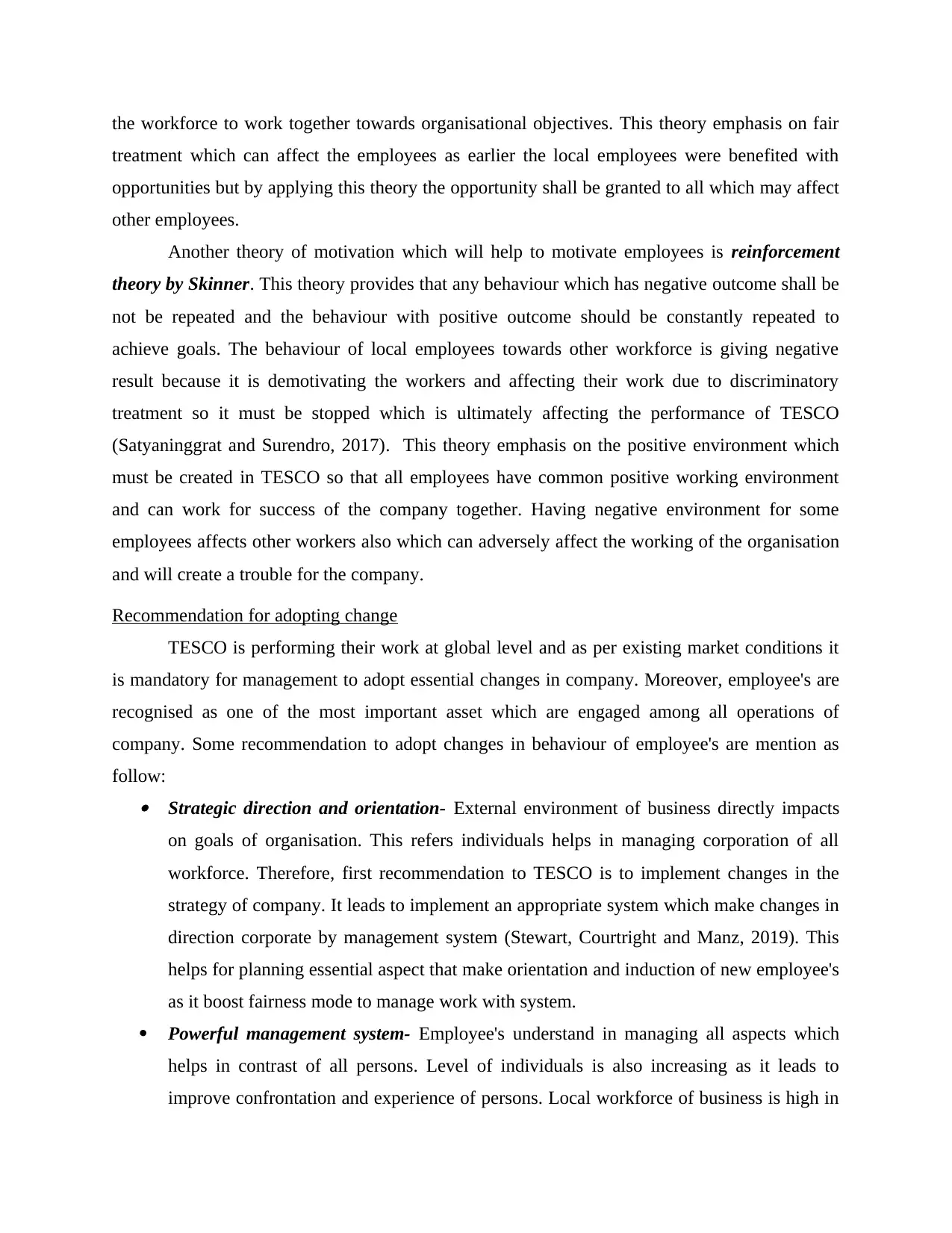
the workforce to work together towards organisational objectives. This theory emphasis on fair
treatment which can affect the employees as earlier the local employees were benefited with
opportunities but by applying this theory the opportunity shall be granted to all which may affect
other employees.
Another theory of motivation which will help to motivate employees is reinforcement
theory by Skinner. This theory provides that any behaviour which has negative outcome shall be
not be repeated and the behaviour with positive outcome should be constantly repeated to
achieve goals. The behaviour of local employees towards other workforce is giving negative
result because it is demotivating the workers and affecting their work due to discriminatory
treatment so it must be stopped which is ultimately affecting the performance of TESCO
(Satyaninggrat and Surendro, 2017). This theory emphasis on the positive environment which
must be created in TESCO so that all employees have common positive working environment
and can work for success of the company together. Having negative environment for some
employees affects other workers also which can adversely affect the working of the organisation
and will create a trouble for the company.
Recommendation for adopting change
TESCO is performing their work at global level and as per existing market conditions it
is mandatory for management to adopt essential changes in company. Moreover, employee's are
recognised as one of the most important asset which are engaged among all operations of
company. Some recommendation to adopt changes in behaviour of employee's are mention as
follow: Strategic direction and orientation- External environment of business directly impacts
on goals of organisation. This refers individuals helps in managing corporation of all
workforce. Therefore, first recommendation to TESCO is to implement changes in the
strategy of company. It leads to implement an appropriate system which make changes in
direction corporate by management system (Stewart, Courtright and Manz, 2019). This
helps for planning essential aspect that make orientation and induction of new employee's
as it boost fairness mode to manage work with system.
Powerful management system- Employee's understand in managing all aspects which
helps in contrast of all persons. Level of individuals is also increasing as it leads to
improve confrontation and experience of persons. Local workforce of business is high in
treatment which can affect the employees as earlier the local employees were benefited with
opportunities but by applying this theory the opportunity shall be granted to all which may affect
other employees.
Another theory of motivation which will help to motivate employees is reinforcement
theory by Skinner. This theory provides that any behaviour which has negative outcome shall be
not be repeated and the behaviour with positive outcome should be constantly repeated to
achieve goals. The behaviour of local employees towards other workforce is giving negative
result because it is demotivating the workers and affecting their work due to discriminatory
treatment so it must be stopped which is ultimately affecting the performance of TESCO
(Satyaninggrat and Surendro, 2017). This theory emphasis on the positive environment which
must be created in TESCO so that all employees have common positive working environment
and can work for success of the company together. Having negative environment for some
employees affects other workers also which can adversely affect the working of the organisation
and will create a trouble for the company.
Recommendation for adopting change
TESCO is performing their work at global level and as per existing market conditions it
is mandatory for management to adopt essential changes in company. Moreover, employee's are
recognised as one of the most important asset which are engaged among all operations of
company. Some recommendation to adopt changes in behaviour of employee's are mention as
follow: Strategic direction and orientation- External environment of business directly impacts
on goals of organisation. This refers individuals helps in managing corporation of all
workforce. Therefore, first recommendation to TESCO is to implement changes in the
strategy of company. It leads to implement an appropriate system which make changes in
direction corporate by management system (Stewart, Courtright and Manz, 2019). This
helps for planning essential aspect that make orientation and induction of new employee's
as it boost fairness mode to manage work with system.
Powerful management system- Employee's understand in managing all aspects which
helps in contrast of all persons. Level of individuals is also increasing as it leads to
improve confrontation and experience of persons. Local workforce of business is high in
Paraphrase This Document
Need a fresh take? Get an instant paraphrase of this document with our AI Paraphraser
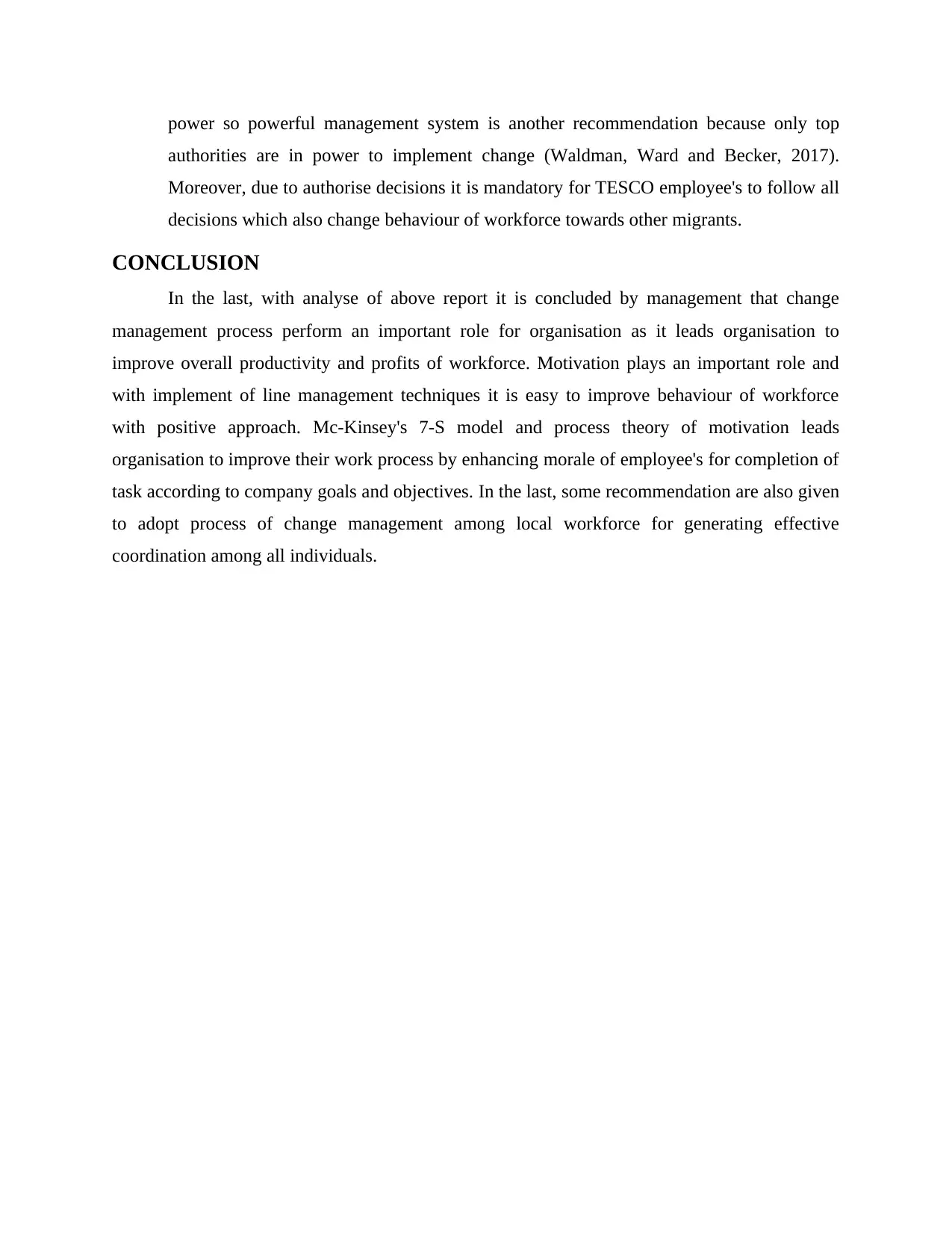
power so powerful management system is another recommendation because only top
authorities are in power to implement change (Waldman, Ward and Becker, 2017).
Moreover, due to authorise decisions it is mandatory for TESCO employee's to follow all
decisions which also change behaviour of workforce towards other migrants.
CONCLUSION
In the last, with analyse of above report it is concluded by management that change
management process perform an important role for organisation as it leads organisation to
improve overall productivity and profits of workforce. Motivation plays an important role and
with implement of line management techniques it is easy to improve behaviour of workforce
with positive approach. Mc-Kinsey's 7-S model and process theory of motivation leads
organisation to improve their work process by enhancing morale of employee's for completion of
task according to company goals and objectives. In the last, some recommendation are also given
to adopt process of change management among local workforce for generating effective
coordination among all individuals.
authorities are in power to implement change (Waldman, Ward and Becker, 2017).
Moreover, due to authorise decisions it is mandatory for TESCO employee's to follow all
decisions which also change behaviour of workforce towards other migrants.
CONCLUSION
In the last, with analyse of above report it is concluded by management that change
management process perform an important role for organisation as it leads organisation to
improve overall productivity and profits of workforce. Motivation plays an important role and
with implement of line management techniques it is easy to improve behaviour of workforce
with positive approach. Mc-Kinsey's 7-S model and process theory of motivation leads
organisation to improve their work process by enhancing morale of employee's for completion of
task according to company goals and objectives. In the last, some recommendation are also given
to adopt process of change management among local workforce for generating effective
coordination among all individuals.
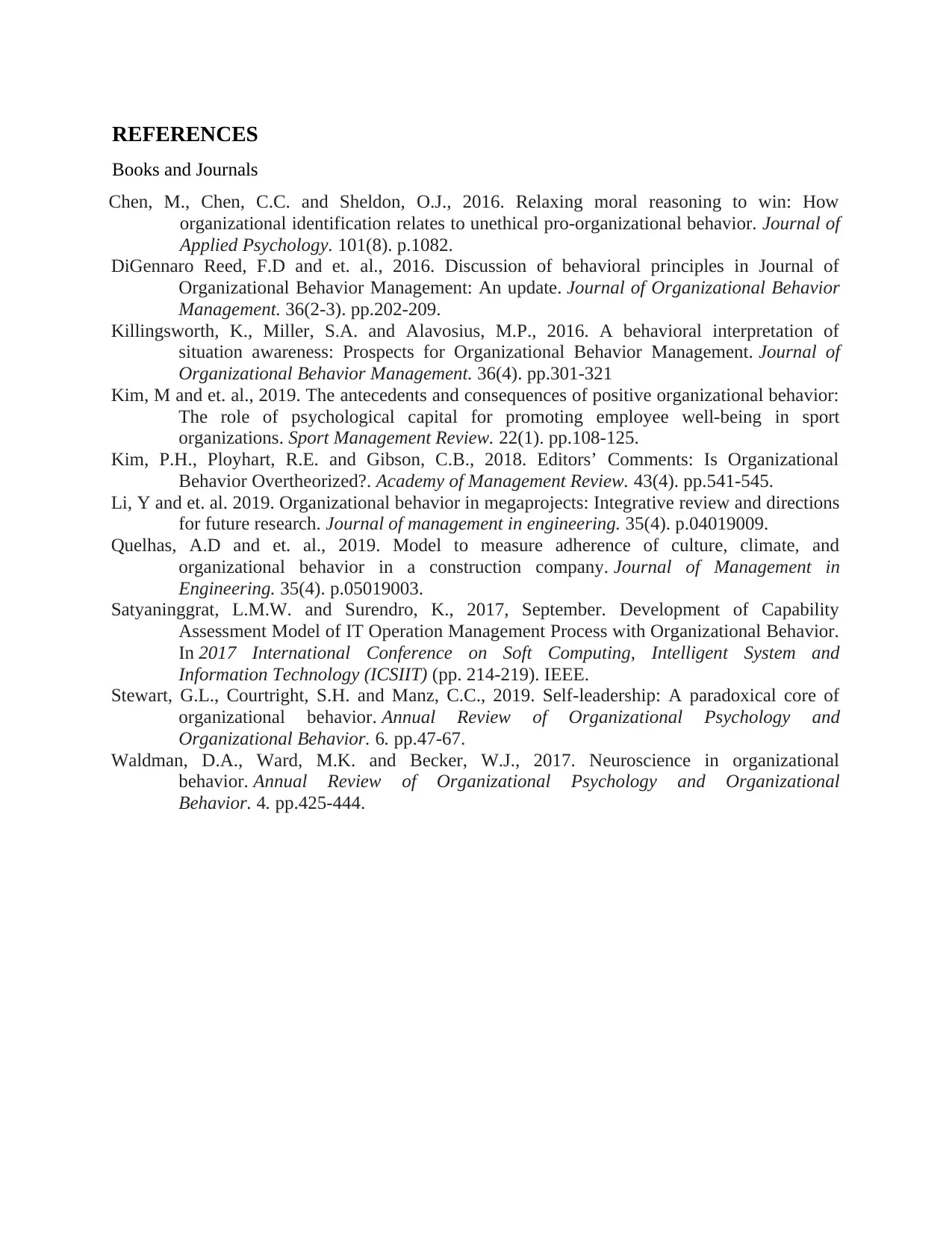
REFERENCES
Books and Journals
Chen, M., Chen, C.C. and Sheldon, O.J., 2016. Relaxing moral reasoning to win: How
organizational identification relates to unethical pro-organizational behavior. Journal of
Applied Psychology. 101(8). p.1082.
DiGennaro Reed, F.D and et. al., 2016. Discussion of behavioral principles in Journal of
Organizational Behavior Management: An update. Journal of Organizational Behavior
Management. 36(2-3). pp.202-209.
Killingsworth, K., Miller, S.A. and Alavosius, M.P., 2016. A behavioral interpretation of
situation awareness: Prospects for Organizational Behavior Management. Journal of
Organizational Behavior Management. 36(4). pp.301-321
Kim, M and et. al., 2019. The antecedents and consequences of positive organizational behavior:
The role of psychological capital for promoting employee well-being in sport
organizations. Sport Management Review. 22(1). pp.108-125.
Kim, P.H., Ployhart, R.E. and Gibson, C.B., 2018. Editors’ Comments: Is Organizational
Behavior Overtheorized?. Academy of Management Review. 43(4). pp.541-545.
Li, Y and et. al. 2019. Organizational behavior in megaprojects: Integrative review and directions
for future research. Journal of management in engineering. 35(4). p.04019009.
Quelhas, A.D and et. al., 2019. Model to measure adherence of culture, climate, and
organizational behavior in a construction company. Journal of Management in
Engineering. 35(4). p.05019003.
Satyaninggrat, L.M.W. and Surendro, K., 2017, September. Development of Capability
Assessment Model of IT Operation Management Process with Organizational Behavior.
In 2017 International Conference on Soft Computing, Intelligent System and
Information Technology (ICSIIT) (pp. 214-219). IEEE.
Stewart, G.L., Courtright, S.H. and Manz, C.C., 2019. Self-leadership: A paradoxical core of
organizational behavior. Annual Review of Organizational Psychology and
Organizational Behavior. 6. pp.47-67.
Waldman, D.A., Ward, M.K. and Becker, W.J., 2017. Neuroscience in organizational
behavior. Annual Review of Organizational Psychology and Organizational
Behavior. 4. pp.425-444.
Books and Journals
Chen, M., Chen, C.C. and Sheldon, O.J., 2016. Relaxing moral reasoning to win: How
organizational identification relates to unethical pro-organizational behavior. Journal of
Applied Psychology. 101(8). p.1082.
DiGennaro Reed, F.D and et. al., 2016. Discussion of behavioral principles in Journal of
Organizational Behavior Management: An update. Journal of Organizational Behavior
Management. 36(2-3). pp.202-209.
Killingsworth, K., Miller, S.A. and Alavosius, M.P., 2016. A behavioral interpretation of
situation awareness: Prospects for Organizational Behavior Management. Journal of
Organizational Behavior Management. 36(4). pp.301-321
Kim, M and et. al., 2019. The antecedents and consequences of positive organizational behavior:
The role of psychological capital for promoting employee well-being in sport
organizations. Sport Management Review. 22(1). pp.108-125.
Kim, P.H., Ployhart, R.E. and Gibson, C.B., 2018. Editors’ Comments: Is Organizational
Behavior Overtheorized?. Academy of Management Review. 43(4). pp.541-545.
Li, Y and et. al. 2019. Organizational behavior in megaprojects: Integrative review and directions
for future research. Journal of management in engineering. 35(4). p.04019009.
Quelhas, A.D and et. al., 2019. Model to measure adherence of culture, climate, and
organizational behavior in a construction company. Journal of Management in
Engineering. 35(4). p.05019003.
Satyaninggrat, L.M.W. and Surendro, K., 2017, September. Development of Capability
Assessment Model of IT Operation Management Process with Organizational Behavior.
In 2017 International Conference on Soft Computing, Intelligent System and
Information Technology (ICSIIT) (pp. 214-219). IEEE.
Stewart, G.L., Courtright, S.H. and Manz, C.C., 2019. Self-leadership: A paradoxical core of
organizational behavior. Annual Review of Organizational Psychology and
Organizational Behavior. 6. pp.47-67.
Waldman, D.A., Ward, M.K. and Becker, W.J., 2017. Neuroscience in organizational
behavior. Annual Review of Organizational Psychology and Organizational
Behavior. 4. pp.425-444.
⊘ This is a preview!⊘
Do you want full access?
Subscribe today to unlock all pages.

Trusted by 1+ million students worldwide
1 out of 9
Related Documents
Your All-in-One AI-Powered Toolkit for Academic Success.
+13062052269
info@desklib.com
Available 24*7 on WhatsApp / Email
![[object Object]](/_next/static/media/star-bottom.7253800d.svg)
Unlock your academic potential
Copyright © 2020–2025 A2Z Services. All Rights Reserved. Developed and managed by ZUCOL.





